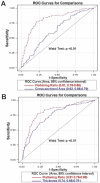Quantitative ultrasound facilitates the exploration of morphological association of the long head biceps tendon with supraspinatus tendon full thickness tear
- PMID: 25412357
- PMCID: PMC4239113
- DOI: 10.1371/journal.pone.0113803
Quantitative ultrasound facilitates the exploration of morphological association of the long head biceps tendon with supraspinatus tendon full thickness tear
Abstract
Backgrounds: Pathology of the long head biceps tendon (LHBT) is associated with rotator cuff tears but whether the LHBT texture changes following supraspinatus tendon full thickness tear (SSFT) can be detected at the extra-articular segment remains unknown. This cross-sectional study aimed to explore the morphological differences of the LHBT in shoulders with and without deficient rotator cuffs by using quantitative ultrasound.
Materials and methods: We selected 145 cases with SSFT and 145 age-and- gender-matched controls. The width, thickness, flattening ratio, cross-sectional area, and echogenicity ratio of the LHBT were measured and a general linear model was used to clarify the relationship between rotator cuff pathology and LHBT morphology. The receiver operating characteristic curves of each parameter were constructed for SSFT discrimination and the maximal Youden indexes were used to define the best cut-off points.
Results: We found increased thickness and cross-sectional area but decreased flattening ratio in shoulders with SSFT, and no between-group differences in the width and echogenicity ratio. The LHBT appearance was modified by biceps peritendinous effusion and medial subluxation, but not by the size of SSFT. The flattening ratio was the best discriminator for SSFT with an area under curve of 0.81 (95% confidence interval, 0.76-0.86). The cut-off values to differentiate between the non-tear and tear groups were 2.00 mm of the thickness, 1.73 of the flattening ratio and 10.53 mm(2) of the cross-sectional area.
Conclusion: Quantitative ultrasound facilitated the detection of the LHBT morphological changes following SSFT and demonstrated its potential utility in discriminating rotator cuff deficiency.
Conflict of interest statement
Figures



References
-
- Chen CH, Hsu KY, Chen WJ, Shih CH (2005) Incidence and severity of biceps long head tendon lesion in patients with complete rotator cuff tears. J Trauma 58: 1189–1193. - PubMed
-
- Chen CH, Chang CH, Su CI, Wang KC, Wang IC, et al. (2012) Classification and analysis of pathology of the long head of the biceps tendon in complete rotator cuff tears. Chang Gung Med J 35: 263–270. - PubMed
-
- Kido T, Itoi E, Konno N, Sano A, Urayama M, et al. (1998) Electromyographic activities of the biceps during arm elevation in shoulders with rotator cuff tears. Acta Orthop Scand 69: 575–579. - PubMed
-
- Namdari S, Donegan RP, Dahiya N, Galatz LM, Yamaguchi K, et al. (2014) Characteristics of small to medium-sized rotator cuff tears with and without disruption of the anterior supraspinatus tendon. J Shoulder Elbow Surg 23: 20–27. - PubMed
-
- Patten RM (1994) Tears of the anterior portion of the rotator cuff (the subscapularis tendon): MR imaging findings. AJR Am J Roentgenol 162: 351–354. - PubMed
Publication types
MeSH terms
LinkOut - more resources
Full Text Sources
Other Literature Sources
Medical

